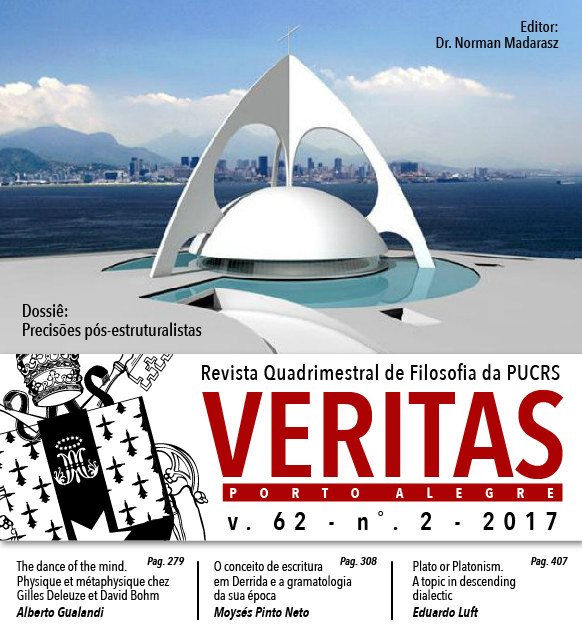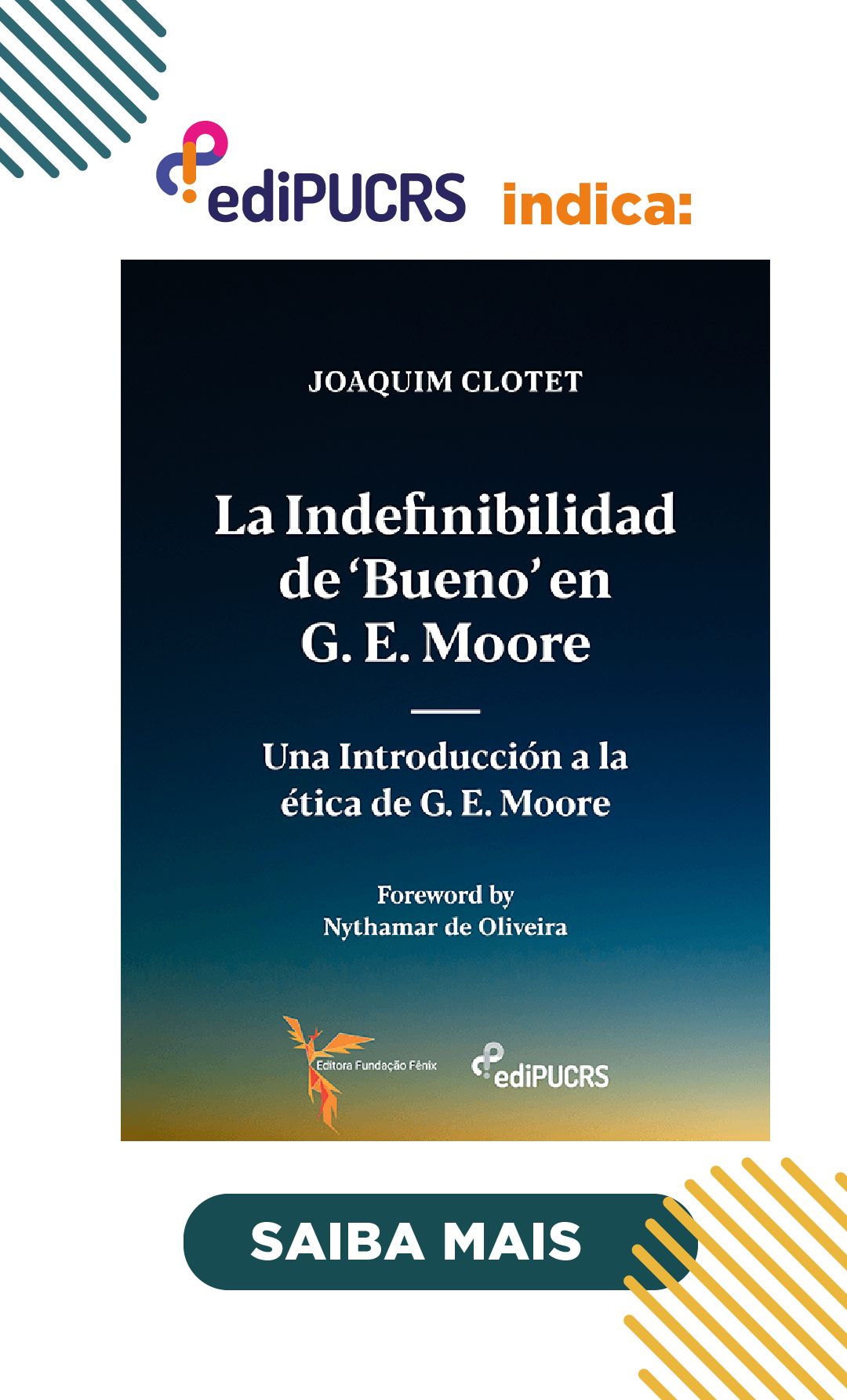The dance of the mind. Physics and metaphysics in Gilles Deleuze and David Bohm
DOI:
https://doi.org/10.15448/1984-6746.2017.2.28508Palabras clave:
Bohm, Deleuze, undivided wholeness in flowing movement, quantum physics, post-structuralism, ontology.Resumen
Over and above differences in terminology and cultural background, we try to show that the quantum physicist, David Bohm (Wilkes-Barre 1917 – London 1992), and poststructuralist philosopher, Gilles Deleuze (Paris 1925 – Paris 1995), shared a common aim in thought: to replace the classical (mechanistic) image of reality, which is still dominant in our time, with a metaphysics finally in agreement with the concepts and results of relativity, quantum mechanics and
contemporary biology. For these two thinkers, the world of things that are well individuated in space and time, and ordered according to mechanical relations of cause and effect, are nothing but the momentary expression of an “undivided wholeness in flowing movement” that constitutes its true ontological ground. By means of this new metaphysics, the world of daily experience and classical science appears as the explicit manifestation or development of implicate order that undivided wholeness contains virtually in itself at deeper and deeper levels of envelopment and imbrication. The explicit world (of classical science and daily experience) is the result of a process of repetition, deceleration and temporal stabilization, triggered by the interaction of our measuring instruments – technical devices, sensory organs and motors, a priori forms and categories of the understanding – with moving wholeness, the thinking and observing subject of which represents a momentary and partial reflection rather than a solitary
and autonomous fragment. By criticizing the classical image of the
correspondence/adequation of being and thought, Bohm and Deleuze
show that the thought seeking to grasp this wholeness in flowing
movement inevitably interacts with it – by modifying, recreating and
accomplishing it in one direction rather than another. Thought thus
resembles a dance that tries to harmonize with the universal flux that
generates and carries it away in a single movement with matter.
***************************************************************************************************************************
Para além das diferenças de terminologia e de background cultural, tenta-se aqui mostrar que o físico quântico David Bohm (Wilkes-Barre 1917 – Londres 1992) e o filósofo pós-estruturalista Gilles Deleuze (Paris 1925 - Paris 1995) tiverem um objetivo comum de pensamento: substituir a imagem clássica (mecanicista) da realidade, ainda dominante em nossa época, por uma metafísica finalmente de acordo com os conceitos e resultados da relatividade, da mecânica quântica e da biologia contemporânea. Para estes dois pensadores, o mundo das coisas bem individuadas no espaço e no tempo, e ordenadas conforme as relações mecânicas de causa e efeito, não é nada outro que a expressão momentânea de uma “Totalidade indivisa em devir” que constitui seu verdadeiro fundamento ontológico. Pelo meio desta nova metafisica, o mundo da experiência cotidiana e da ciência clássica aparece como a manifestação explicita ou desenvolvida da ordem implícita que a totalidade indivisa contém virtualmente nela mesma em níveis de envolvimento e de imbricação sempre mais profundos. O mundo explícito (da ciência clássica e da experiência cotidiana) é o resultado de um processo de repetição, desaceleração e estabilização temporal, desencadeado pela interação de nossos instrumentos de medição -- aparelhos técnicos, órgãos sensoriais e motores, formas “a priori” e categorias do entendimento – com uma totalidade movente no qual o sujeito pensante e observante representa um reflexo momentâneo e parcial ao invés de um fragmento solitário e autônomo. Ao criticar a imagem clássica da correspondência/adequação entre o ser e o pensamento, Bohm e Deleuze mostram finalmente que o pensamento que intenta capturar esta Totalidade em devir interage inevitavelmente com ela, modificando-a, recriando-a e realizando-a em uma direção ao invés de outra. O pensamento se aparenta assim a uma dança que tenta se harmonizar com o flux universal que o gera e o leva em um movimento só com a matéria.
Palavras-chave: Bohm; Deleuze; totalidade indivisa em devir; física quântica; pós-estruturalismo; ontologia.
Descargas
Citas
BADIOU, A. Deleuze. La clameur de l’Être. Paris: Hachette 1997.
BARROW, J . Theories of Everything. Oxford: Oxford Univ. Press, 1991.
BOHM , D. Wholeness and the Implicate Order. London/New York: Routledge, 1980.
______. On creativity. Ed. by L. Nichol. London: Routledge, 2005 (1998).
______. A Suggested Interpretation of the Quantum Theory in Terms of “Hidden Variables”. Part. I and II. In: Physical Review, 85 (1952). DOI: https://doi.org/10.1103/PhysRev.85.180
CANGUILHEM, G. “Machine et organisme”. In: La connaissance de la vie. Paris: Vrin, 1965.
CARR, B. (Ed.). Universe or Multiverse? Cambridge: Cambridge University Press, 2007. DOI: https://doi.org/10.1017/CBO9781107050990
CARROLL, S. B. Endless Forms Most Beautiful. The New Science of Evo-Devo. Armonk, New York: Baror International Inc., 2005.
CAVAZZINI, A.; GUALANDI, A. (Éd.). “Logiche del vivente”. Evoluzione, sviluppo, cognizione nell’epistemologia francese contemporânea. Discipline filosofiche, XIX, 1 (2009).
DAVIES, P. The Accidental Universe. Cambridge: Cambridge University Press, 1982.
______. Cosmic Jackpot: Why Our Universe Is Just Right for Life. New York: Houghton Mifflin Harcourt, 2007.
______. The Mind of God. New York: Simon & Schuster, 1992. (Trad. fr., L’esprit de Dieu. Paris: Hachette, 1998.)
DELEUZE, G. La philosophie critique de Kant. Paris: PUF, 1963.
______. Spinoza et le problème de l’expression. Paris: De Minuit, 1968.
______. Différence et répétition. Paris: PUF, 1968.
______. “Responses to a Series of Questions”, dans Collapse, III (2007).
(Originairement dans Villani, A. La guêpe et l’orchidée. Paris: Belin, 999).
______. Introduction à J. Malfatti de Montereggio. Études sur la Mathèse ou anarchie et hiérarchie de la science. Paris: du Griffon d’Or, 1946.
(Trad. anglaise, Mathesis, science and Philosophy, dans Collapse, III.)
______. Deux régimes de fous. Paris: éd. De Minuit, 2003.
DELEUZE, G.; GUATTARI, F. L’Anti-OEdipe. Paris: éd. De Minuit, 1972/1973.
______. Mille plateaux. Paris: éd. De Minuit, 1980.
DEUTSCH, D. The Structure of the Multiverse, 2001. <http://xxx.lanl.gov/abs/quantph/0104033>.
GILBERT, S.F., Developmental Biology. 7. ed. New York: Sinauer, 2003.
GOULD, S. J. Ontogeny and Phylogeny. Cambridge; London: The Belknap Press of Harvard University Press, 1977.
______. The Structure of Evolutionary Theory. Cambridge, Mass.: President and Fellows of Harvard College, 2002.
GOULD, S. J.; VRBA, E. S. “Exaptation – a missing term in the science of form”. Paleobiology, 8, 1 (1982). (Trad. it., Exaptation, il bricolage dell’evoluzione. Torino: Boringhieri, 2008.) DOI: https://doi.org/10.1017/S0094837300004310
GUALANDI, A. La rupture et l’événement. Le problème de la vérité scientifique dans la philosophie française contemporaine. Paris: L’Harmattan, 1998.
______. Deleuze. Paris: Les Belles Lettres, 1998.
______. «La renaissance des philosophies de la nature et la question de l’humain», dans Maniglier, P. (Éd. par). Le moment philosophique des années soixante. Paris: PUF, 2011.
HOFFMANN, E. Die Sprache und die archaische Logik. Tübingen: Mohr, 1925.
JAMES, W. “The Will to Believe, 1895”. In: The Works of William James. Cambridge, Mass.: President and Fellows of Harvard College, 1979.
JAYNES, J. The Origin of Consciousness in the Breakdown of the Bicameral Mind, 1976.
(Trad. it., Il crollo della mente bicamerale e l’origine della coscienza, Milano: Adelphi, 1984.)
A. Gualandi – The dance of the mind 306 Veritas | Porto Alegre, v. 62, n. 2, maio-ago. 2017, p. 279-307 DOI: https://doi.org/10.15448/1984-6746.2017.2.28508
JOSEPHSON, B.; RAMACHANDRAN, V. S. Consciousness and the physical world. Oxford: Pergamon Press, 1980.
LAKOFF, G.; JOHNSON, M. Metaphors we live by. Chicago: The university of Chicago Press, 1980; London, 2003. DOI: https://doi.org/10.7208/chicago/9780226470993.001.0001
LAKOFF, G.; NÚÑEZ, R. Where Mathematics Comes From. How the Embodied Mind Brings Mathematics into Being. New York: Basic Books, 2000.
(Trad. it., Da dove viene la matematica, Torino: Boringhieri, 2005).
MACKAY, R. “Editorial introduction”, dans Collapse, III (2007).
MELANDRI, E. La linea e il circolo. Bologna: Il Mulino, 1968. (Macerata: Quodlibet, 2004.)
______. L’analogia, la proporzione, la simmetria. Milano: ISEDI, 1974.
MEYERSON, E. Identité et réalité. Paris: Vrin, 1951 (Paris: Alcan, 1908).
NEEDHAM, J. The Grand Titration: Science and Society in East and West. London: Allen & Unwin, 1969.
PEAT, D. Infinite Potential. The Life and Times of David Bohm. New York: Basic Books, 1996.
ROSE, S. Lifelines: Life Beyond the Gene. New York: Oxford University Press, 2003.
SHELDRAKE, R. Morphic Fields and Morphic Resonance, 2005. (Online). In: <http://www.sheldrake.org/Articles&Papers/papers/morphic/morphic_intro.html>. DOI: https://doi.org/10.1080/02604020500406248
SIMONDON, G. L’individu et sa genèse physico-biologique. Paris: PUF, 1964.
STAPP, H. Mind, matter and quantum mechanics. Berlin: Springer, 1993. DOI: https://doi.org/10.1007/978-3-662-08765-7
Descargas
Publicado
Cómo citar
Número
Sección
Licencia
Derechos de Autor
La sumisión de originales para la Revista Veritas implica la transferencia, por los autores, de los derechos de publicación. El copyright de los artículos de esta revista es el autor, junto con los derechos de la revista a la primera publicación. Los autores sólo podrán utilizar los mismos resultados en otras publicaciones indicando claramente a Revista Veritas como el medio de la publicación original.
Creative Commons License
Excepto donde especificado de modo diferente, se aplican a la materia publicada en este periódico los términos de una licencia Creative Commons Atribución 4.0 Internacional, que permite el uso irrestricto, la distribución y la reproducción en cualquier medio siempre y cuando la publicación original sea correctamente citada. Copyright: © 2006-2020 EDIPUCRS






